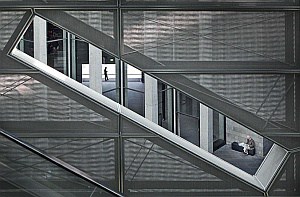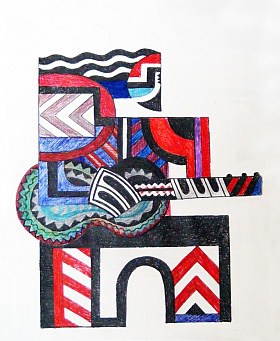East 2012, the major art event on the Hastings City Art Gallery’s calendar appears, at first, to have revived the old Hawke’s Bay Review format of a guest selector. The resemblance is only superficial, though, and there is a huge difference between the two. The gestation of East 2012 and its evolution from The Review has been long and involved and is worth looking at.
Until 2007 the Hawke’s Bay Review was the major showcase for local artists who submitted work for consideration and a guest selector decided who was in and who was not. Sadly, the selections became increasingly erratic. To be fair, it is often difficult to assess unfamiliar artists on just one or two works and to tune in to what they are doing (or not doing). Increasingly sub-standard work appeared in the show and many established artists stopped supporting it.
In response, Creative Hawke’s Bay initiated a new format: the Hawke’s Bay Invitational, using an expert panel to invite the most appropriate artists to exhibit. This brought a great improvement but the problems weren’t over yet. Freed of a curatorial presence, some artists were less than rigorous in vetting the quality of their submissions and there were the attendant problems of a large and disparate selection panel.
The process was again improved by introducing a guest curator to monitor the submissions but some criticism still remained. Invited artists sometimes found that major work they had completed for the show was unwanted and there was a feeling that The Invitational was a closed shop and difficult for new artists to break into.
After much consultation, the Hastings City Art Gallery has returned to using an outside selector for East 2012. This time, however, the format provides for a thorough dialogue over a period of time between the curator and the artists rather than the ‘hit or miss’ system of old. Some projects were even accepted as proposals to be completed for this show. Applications were open to any artists with Hawke’s Bay connections.
As for the name East 2012, it marks the start of a strategy, in co-operation with Whanganui and Taranaki, to lift the profile of artists across the middle North Island. Just thumb through copies of our two major art periodicals and you will see how art appears to stop happening south of the Bombay Hills and re-appears again around Porirua.
So, has it worked? Well, yes. There really are some fresh faces included and a re-appearance of some seemingly forgotten artists. Sure, there are a few works that are a bit lightweight for my tastes, but that will always happen and the curator, the respected Bill Milbank, makes a convincing case in his catalogue essay to support his inclusions.
I am disappointed not to see work from a number of very good artists who were not selected but that is the way that these things go. Remember when the Wine Country Gallery staged a Salon des Refuses from the Hawke’s Bay Review? You could assemble quite a decent show from the artists not in East 2012, but perhaps that reflects a growing strength in the local art scene.
As for the exhibition itself, there is a consistency shown which keeps it tight-knit and helps viewers to relate to each succeeding work as they move around. Curiously, for all of its Hawke’s Bay connections, this show presents a wider, outward-looking view of the world than did its predecessors.
David Trubridge may have used Manuka as the genesis of his work, but the values of proportion and intellectual engagement with viewers are universal and, for all its high-tech manufacture, the harmony between art and nature is timeless.
Matthew Couper may be locally born and bred, but he has found his milieu in the rich symbolism of the Spanish Colonial artists of America. Using this narrative tradition, he looks at the human need for beliefs and symbols on which to hang hopes and fears and laces them with autobiographical events.
There is plenty for viewers to do here too. You can ask yourself if Helen Kerridge’s upset wine glass is simply an exquisitely rendered piece of close observation or is it significant of wider trends and events in the world around us. There is a clue in the title.
I like the unselfconscious cross culturism of the show. Milbank points to Prakesh Patel, “an Indian born in New Zealand, educated in Hawke’s Bay …. and vibrantly references his inherited relationship with India”. In comparison, Patrick Tyman is an Englishman, born in India but lives in Hawke’s Bay. His painting tells that story with a dense tableau of cultural icons that have informed him, set against a background of Hawke’s Bay hills.
There is a healthy presence of the interaction between Mãori and European traditions that has vitalised so much of our art. Walter Dewes’ Kaitiakitanga is especially striking. This guardian is scary and manic as it carries past and present symbols of life and death, land clearance, monetarism and more. See how many you can identify. The scale and agitated line amplifies the nervous energy of the work.
You can find relief from tension in the cerebral coolness of Peter Baker’s This, That and the Others, a cryptic work that invites contemplation. So too, does Jeffrey Drabble’s photograph Text De Sending which can be enjoyed for its intricate formal structure or as a disquieting insight into urban alienation. Just as impressive, in a different way is Richard Brimer’s Untitled landscape photograph. There are no tricks here, nothing overtly clever; it is just evocative and beautiful.
One thing about this exhibition that especially warms my old heart is the abundance of good painting which seems almost unfashionable these days. Wellesley Binding’s The Works is an epic achievement even by his high standards. This parable of corporate and global structures insidiously growing and crumbling, channelling our lives is in a grand tradition of allegorical painting with antecedents in late Gothic masters such as Bosch and Breugel. It is a fascinating and disturbing world of secrecy and duplicity painted with consummate skill. Even the “accidental” elements like the splashes and dribbles do exactly the right things as Binding layers and orchestrates his colours. This is terrific painting.
There is so much more to enjoy here from the installation of the uncompromising David Guerin to Nicole Sanders-O’Shea’s intimate fragments of domestic life, to the joyous kitsch of Jo Blogg and the ephemeral delicacy of Kathy Boyle’s Terra Flora.
The more I looked at this show, the more I liked it.



